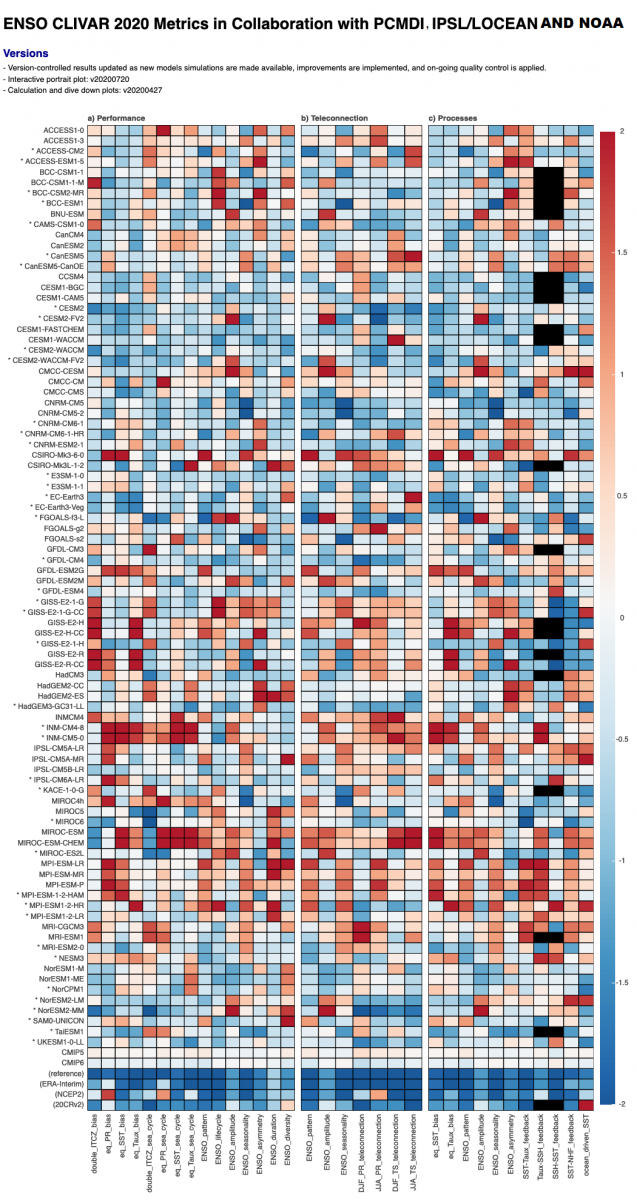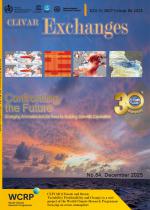CLIVAR 2020 ENSO Metrics Package

 The El Niño-Southern Oscillation (ENSO) is the dominant mode of interannual variability on the planet, with far-reaching impacts on climate around the world. It is therefore key to evaluate the simulations of ENSO in the state-of-the-art numerical models used to study past, present, and future climate. The CLIVAR ENSO metrics package — a community-wide effort led by the CLIVAR Pacific Region Panel, in close collaboration with PCMDI, IPSL/LOCEAN, and NOAA — was developed to evaluate ENSO variability, teleconnections, and processes in climate models. The package, which is documented in Planton et al. (Bulletin of the American Meteorological Society, 2021), enables multi-model diagnosis, comparison, and evaluation, facilitated by software tools that (1) point to properties that need to be improved; (2) monitor progress made from one generation of models to the next; (3) aid in the selection of models that are well suited for particular applications; (4) reveal links among model biases and illuminate their impacts on ENSO’s evolution and sensitivity to climate change; and (5) contribute to ENSO literacy among model developers and users. The package is designed to interface with existing model evaluation software architectures, to access and process multi-petabytes of climate model simulations. Planton et al. (2021) apply the package to the Coupled Model Intercomparison Project phase 5 (CMIP5) and phase 6 (CMIP6) historical simulations. Relative to CMIP5, CMIP6 simulations significantly improve for 8 of the 24 ENSO-relevant metrics – with most CMIP6 models exhibiting an improved tropical Pacific seasonal cycle and ENSO teleconnections. Only one metric (the coupling between subsurface and surface temperature anomalies in the eastern equatorial Pacific) was found to significantly worsen from CMIP5 to CMIP6.
The El Niño-Southern Oscillation (ENSO) is the dominant mode of interannual variability on the planet, with far-reaching impacts on climate around the world. It is therefore key to evaluate the simulations of ENSO in the state-of-the-art numerical models used to study past, present, and future climate. The CLIVAR ENSO metrics package — a community-wide effort led by the CLIVAR Pacific Region Panel, in close collaboration with PCMDI, IPSL/LOCEAN, and NOAA — was developed to evaluate ENSO variability, teleconnections, and processes in climate models. The package, which is documented in Planton et al. (Bulletin of the American Meteorological Society, 2021), enables multi-model diagnosis, comparison, and evaluation, facilitated by software tools that (1) point to properties that need to be improved; (2) monitor progress made from one generation of models to the next; (3) aid in the selection of models that are well suited for particular applications; (4) reveal links among model biases and illuminate their impacts on ENSO’s evolution and sensitivity to climate change; and (5) contribute to ENSO literacy among model developers and users. The package is designed to interface with existing model evaluation software architectures, to access and process multi-petabytes of climate model simulations. Planton et al. (2021) apply the package to the Coupled Model Intercomparison Project phase 5 (CMIP5) and phase 6 (CMIP6) historical simulations. Relative to CMIP5, CMIP6 simulations significantly improve for 8 of the 24 ENSO-relevant metrics – with most CMIP6 models exhibiting an improved tropical Pacific seasonal cycle and ENSO teleconnections. Only one metric (the coupling between subsurface and surface temperature anomalies in the eastern equatorial Pacific) was found to significantly worsen from CMIP5 to CMIP6.
For further details, see Planton et al. (2021) and the project web page and wiki.











Add new comment